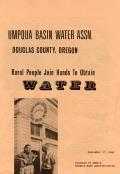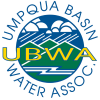The History of your Association
Umpqua Basin Water Association was the first rural water system in Oregon to be financed in 1966 by a Farmers Home Administration loan, which made possible the construction of Umpqua Basin Water Association’s water treatment plant and storage facilities for a rural water system. The system at the time of the original loan, was the largest F.H.A. project west of the Mississippi, and the second largest in the nation to be built under F.H.A. funds. UBWA is credited with being responsible for much of the growth and development in the Wilbur, Garden Valley, Melrose, Lookingglass, and adjoining areas.
Incorporated in 1965 in the state of Oregon as a non-profit co-operative, the water system was put into operation in May of 1967, supplying some 400 original members.
By 1973, the system covered approximately 55 square miles with nearly 90 miles of main transmission lines and serving 967 members. Through continuous growth and the merger with the Lookingglass Water Association in January of 1973, the Association’s distribution system expanded to cover 75 square miles with 215 miles of main transmission lines. The membership at that time had grown to just over 2300 members.
As of the end of 2024 your Association served 3672 members which equates to approximately 9,499 people with 22 reservoirs and 14 pump stations. Your Association has a staff of 10 personnel. The current storage capacity is 5.486 million gallons of water and the service area is spread out over 100 square miles. The coverage in square miles is equivalent to the area of Baton Rouge, Louisiana or twice the area of Des Moines, Iowa and ten times the area of Cleveland, Ohio. When you couple those facts with about 280 miles of pipeline in the ground, you get a clear image of the overall area that your Association serves and maintains.
Newsletter




